
Chinese art is visual art that, whether ancient or modern, originated in or is practiced in China or by Chinese artists. The Chinese art in the Republic of China (Taiwan) and that of overseas Chinese can also be considered part of Chinese art where it is based in or draws on Chinese heritage and Chinese culture. Early "stone age art" dates back to 10,000 BC, mostly consisting of simple pottery and sculptures. After this early period Chinese art, like Chinese history, is typically classified by the succession of ruling dynasties of Chinese emperors, most of which lasted several hundred years.

Chinese folk art are artistic forms inherited from a regional or ethnic scene in China. Usually there are some variation between provinces. Individual folk arts have a long history, and many traditions are still practiced today. The general definition of folk art incorporates Chinese art forms that are not classified as Chinese fine art.

Zhao Mengfu, was a descendant of the Song Dynasty's imperial family through Emperor Xiaozong’s brother Zhao Bogui who married a lady surnamed Song who was the granddaughter of Emperor Huizong. Zhao Bogui was a descendant of Emperor Taizu, through his son Zhao Defang.

Bada Shanren was a Han Chinese painter of ink wash painting and a calligrapher. He was of royal descent, being a direct offspring of the Ming dynasty prince Zhu Quan who had a feudal establishment in Nanchang. His master lineage's accession was revoked following the last Ning Lineage King Zhu Chenhao's rebellion in 1521, but the rest of the lineage was allowed to retain status in Jiangxi. Art historians have named him as a brilliant painter of the period.
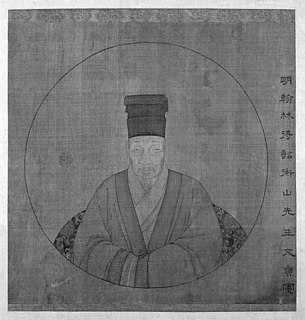
Wen Zhengming, born Wen Bi, was a leading Ming dynasty painter, calligrapher, poet, and scholar. He was regarded as one of the Four Masters of Ming painting.
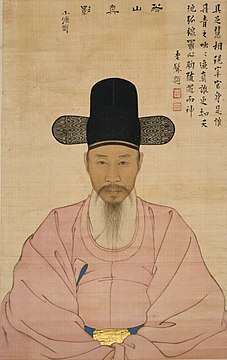
Korean painting includes paintings made in Korea or by overseas Koreans on all surfaces. It includes art as old as the petroglyphs through post-modern conceptual art using transient forms of light. Calligraphy rarely occurs in oil paintings and is dealt with in the brushwork entry, Korean calligraphy. Like arts of East Asia, beauty of space is important for Korean painting.
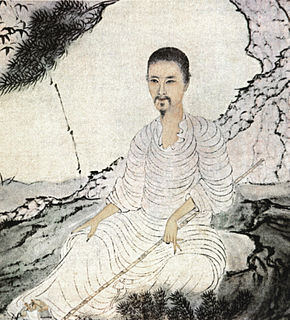
Shitao or Shi Tao, born into the Ming dynasty imperial clan as Zhu Ruoji (朱若極), was a Chinese landscape painter in the early Qing Dynasty (1644–1911).

Shen Zhou, courtesy name Qi'nan (启南) and Shitian (石田), was a Chinese painter in the Ming dynasty.
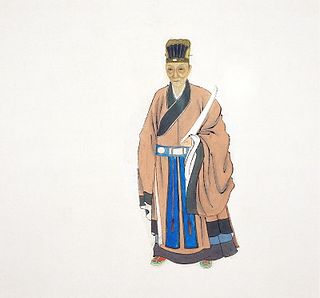
Dong Qichang, was a Chinese painter, scholar, calligrapher, and art theorist of the later period of the Ming Dynasty.
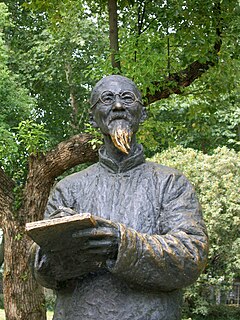
Huáng Bīnhóng was a Chinese literati painter and art historian born in Jinhua, Zhejiang province. His ancestral home was She County, Anhui province. He was the grandson of artist Huang Fengliu. He would later be associated with Shanghai and finally Hangzhou. He is considered one of the last innovators in the literati style of painting and is noted for his freehand landscapes.
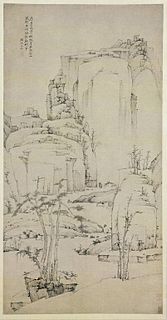
Hong Ren, who is also known as Hongren, was an early Qing painter and a member of the Anhui school of painting. His birth name was Jiang Fang. After the fall of the Ming dynasty he became a monk, as did Zhu Da, Shitao, and Kun Can. They protested the fall of the Ming dynasty by becoming monks. Hong Ren's style has been said to "[represent] the world in a dematerialized, cleansed version ... revealing his personal peace through the liberating form of geometric abstraction."
Ren Yi, also known as Ren Bonian, was a painter and son of a rice merchant who supplemented his income by doing portraits. He was born in Zhejiang, but after the death of his father in 1855 he lived in Shanghai. This move placed him in a more urban world that was exposed to Western thinking. In Shanghai he became a member of the Shanghai School which fused popular and traditional styles. Ren Bonian ranked with Ren Xiong, Ren Xun and Ren Yu as the "Four Rens."

Kun Can (髡殘) was a Chinese painter from Hunan who spent most of his life in Nanjing. He became a Chan Buddhist monk at an early age and in Nanjing was abbot of a monastery on Niushou Shan. His style of landscape painting was influenced by Wang Meng and he is one of the Four Monk Masters in the early Qing Dynasty. The others being Zhu Da, Hong Ren, and Shitao. As he was also known as Shi Xi he was at times said to be one of the "Two Shi". Few of Kun Can's works survive.

Dwelling in the Fuchun Mountains is one of the few surviving works by painter Huang Gongwang (1269–1354) and it is considered to be among his greatest works. Painted between 1348 and 1350, the Chinese landscape painting was burnt into two pieces in 1650. Today, one piece is kept in the Zhejiang Provincial Museum in Hangzhou, while the other piece is kept in the National Palace Museum in Taipei. The entire painting combined would measure 691.3 cm in length.
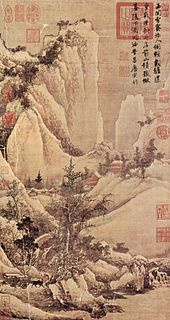
Tang Yin, courtesy name Tang Bohu (唐伯虎), was a Chinese scholar, painter, calligrapher, and poet of the Ming dynasty period whose life story has become a part of popular lore. Even though he was born during the Ming dynasty, many of his paintings, especially those of people, were illustrated with elements from Pre-Tang to Song dynasty art.

During the Ming dynasty (1368–1644), Chinese painting progressed further basing on the achievements in painted art during the earlier Song dynasty and Yuan dynasty. The painting techniques which were invented and developed before the Ming period became classical during this period. More colours were used in painting during the Ming dynasty. Seal brown became much more widely used, and even over-used during this period. Many new painting skills/techniques were innovated and developed, calligraphy was much more closely and perfectly combined with the art of painting. Chinese painting reached another climax in the mid and late Ming. The painting was derived in a broad scale, many new schools were born, and many outstanding masters emerged.
Xiao Yuncong was a famed Chinese landscape painter, calligrapher, and poet during the late Ming and early Qing dynasties.
Liu Jue ; ca. 1409–1472 was a Chinese landscape painter, calligrapher, and poet during the Ming Dynasty (1368–1644).
The Xiling Seal Art Society (Chinese: 西泠印社) is a Chinese arts organisation based in Hangzhou, Zhejiang Province, PRC. It was founded in 1904 but, with antecedents dating back to the Ming and Qing dynasties, is one of China's most important traditional stone seal engraving associations.
Shi Lu, born Feng Yaheng, was a Chinese painter, wood block printer, poet and calligrapher. He based his pseudonym on two artists who greatly influenced him, the landscape painter Shitao and writer Lu Xun.




















